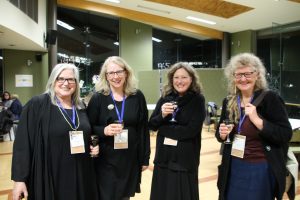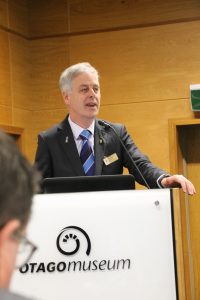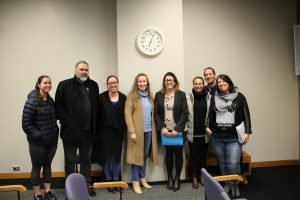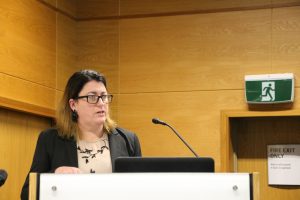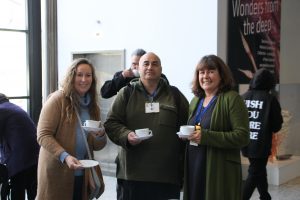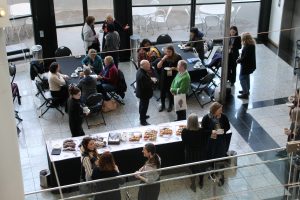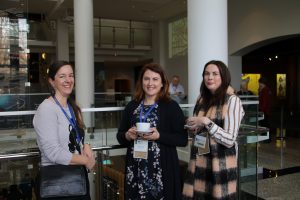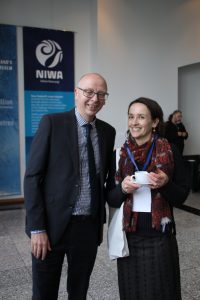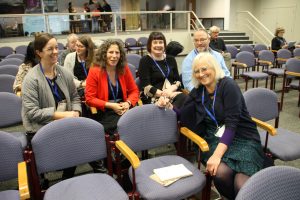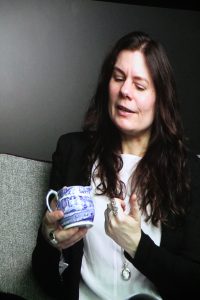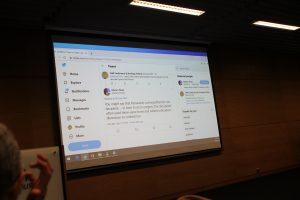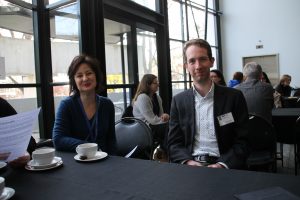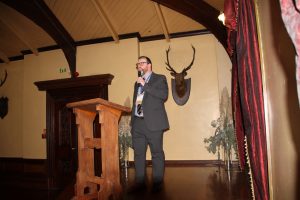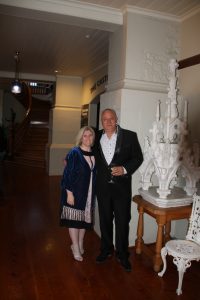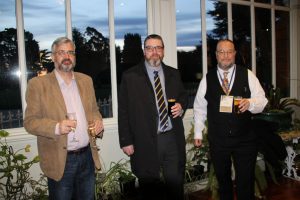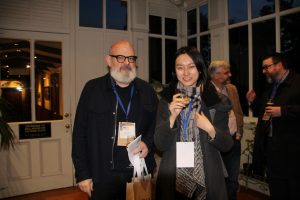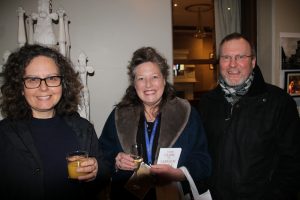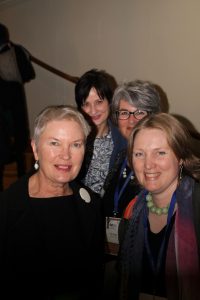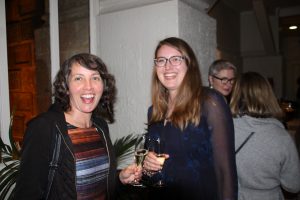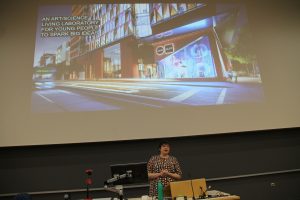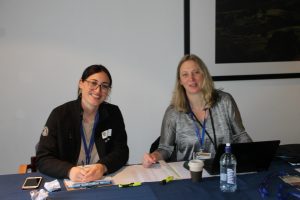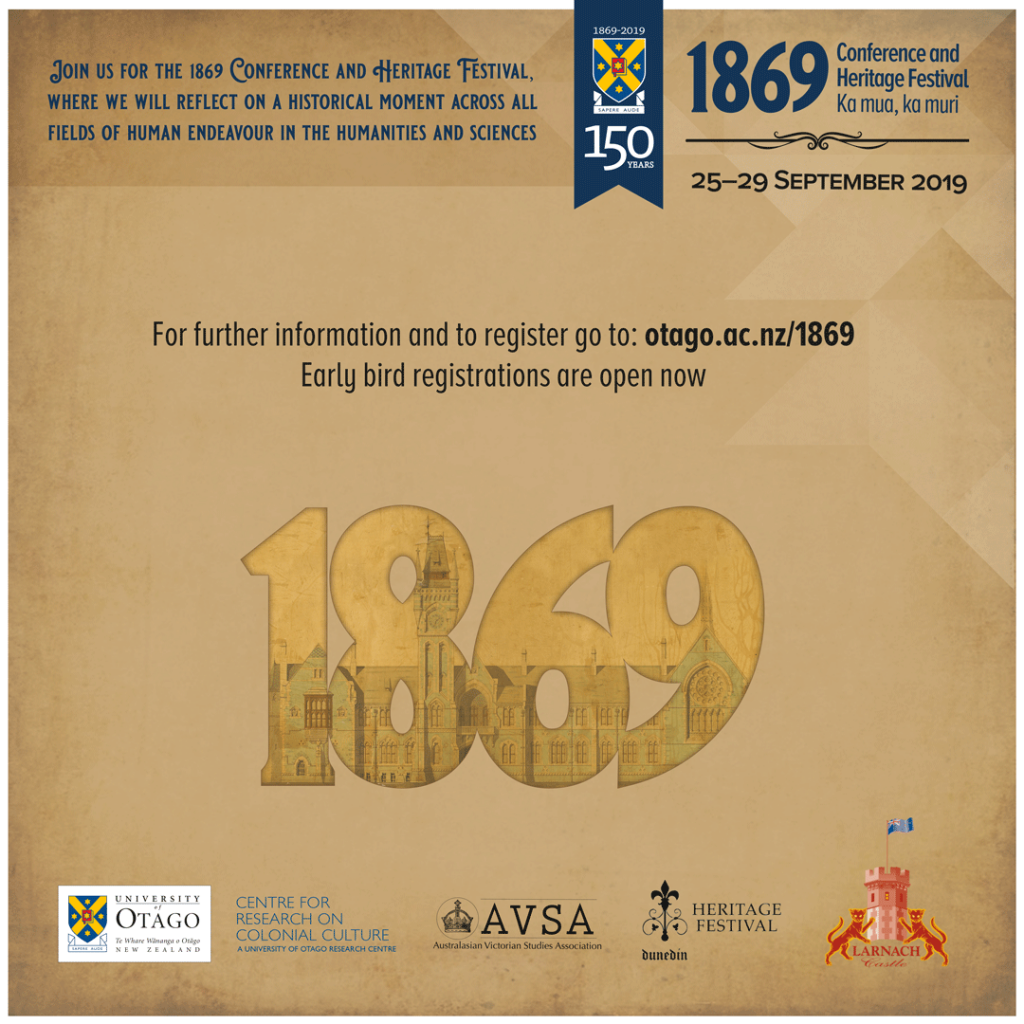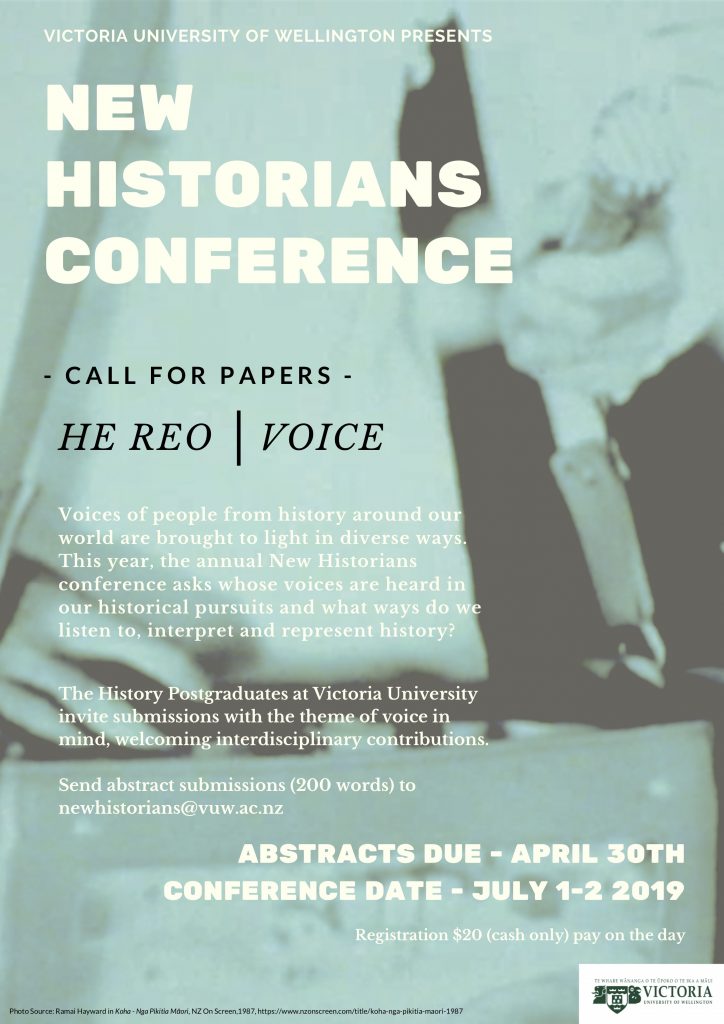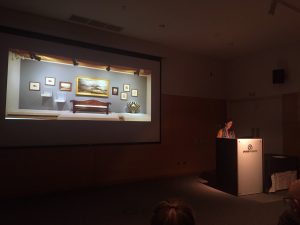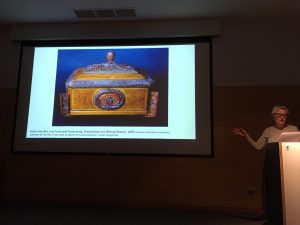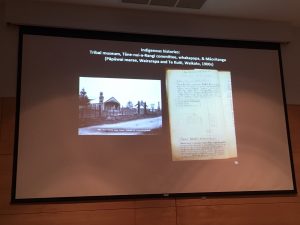The amazing “1869” conference
Otago hosted a brilliant hybrid conference this week, the “1869 Conference and Heritage Festival”. By “hybrid” I mean that it was the annual conference for the Australasian Victorian Studies Association, while also celebrating the University of Otago’s 150th anniversary, and sitting alongside the Dunedin Heritage Festival. While the Centre for Colonial Culture was a key sponsor, with Associate Professor Angela Wanhalla as one of the co-convevors (together with Kirby Hallum), a cross section of the university’s faculty was represented on the organising committee. The melange meant that most people engaged with papers that they would normally never encounter at their more usual disciplinary conferences, although this added to, rather than diminished, the event’s success. [See below for photos]
On Wednesday evening, the conference began with an all-women panel, looking at “Heritage through Words, Pictures and Threads”. Chaired by Kirby, the panel featured the novelist and academic, Tina Makereti, who discussed her latest novel, The Imaginary Lives of James Poneke; Lisa Chatfield, the producer for the BBC television adaptation of The Luminaries; Madeleine Seys, author of Fashion and Narrative in Victorian Popular Literature; and Otago’s Catherine Smith, an expert behind the science of traditional Māori weaving. This was a wonderful collaboration, exciting for those interested in the sumptuous garments of the Victorian era, but also drawing a number of different “threads” together. This was followed by a reception held in Te Tumu: School of Māori, Pacific and Indigenous Studies.
1869 was formally opened in the Otago Museum on Thursday (26 September) with a mihi whakatau from Tuari Pōtiki representing both Kāi Tahu and the university, a short welcome from the DVC Research, Professor Richard Blaikie, and an amusing and uplifting speech from the Hon Grant Robertson, an Otago alumnus as well as the current (among other portfolios) Minister for Arts, Culture and Heritage. The PVC Humanities, Professor Tony Ballantyne then introduced the first keynote speaker, Megan Pōtiki of Te Tumu, who discussed how the school established in 1869 contributed to the demise of the speaking of te reo Māori at Ōtākou, just under 30 minutes drive from the city. However, in more recent years the concerted efforts of local people have seen the revival in the language at the kāik.
There are too many individual presentations to mention them all. Most were what one might expect at a history or literature conferences, but also sprinkled with a few science-orientated talks as well. Several stand out, such as the presentation by Dr Ian Chapman on the links between Jules Verne’s From the Earth to the Moon with David Bowie’s Space Oddity – including a live band!; Lyndon Fraser’s swirling PowerPoint while discussing women’s wills in Victorian Canterbury; and Lyall Hanton’s physically animated talk on Joseph Mellor’s 16 million words on the Periodic Table. But the organisers were gratified at the high quality of all the panel presentations.
The conference highlights, of course, were the keynotes. On Thursday evening, people braved a dismal night to listen to Helen Pearson, editor of Nature, a journal that shares a 150th birthday with the university. Helen gave a wonderful talk on the past, present and future of this illustrious journal, noted not just for its academic papers but the science reporting and commentary. The “past” incorporated some of the journal’s many key publications, such as Francis Crick and James Watson’s groundbreaking paper on DNA in 1929, as well as a notable failure, an account on cold fusion. Helen also discussed Nature’s current situation, and how that may change with the growing demand for open-access publications.
Marian Thain, of Kings College London, was unable to make it to Dunedin for the conference, but nevertheless presented on“Cosmopolitanism, Nationalism and the Politics of Parnassian Poetry (1860s-1880s)” on Friday. An exploration of how English poets adapted the ballade, a French poetry genre, the talk discussed how the Parnassian poets’ efforts spawned tensions between those who favoured a more international outlook and those who advocated for more British forms of verse. Marion pre-recorded her video presentation, and invited questions via Twitter both during and after its viewing, which worked really successfully. Indeed, the conference goers included a number of enthusiastic tweeps, with the conference at one point trending up to 5th place in New Zealand’s Twitter rankings. See #otago1869 and #avsa2019.
Conference goers were treated on Friday evening to a bus trip up to the historic Larnarch’s Castle atop the Otago Peninsula. On arrival, just before dusk, the swirl of bagpipes greeted us as we alighted the buses and entered the castle. After newcomers had undertaken a tour of the building and we had all had the opportunity to wet the whistle, we all entered into the banquet hall for a marvellous feast. The “entertainment” for the evening was Professor Liam McIlvanney, who gave a wonderful speech arguing that Rev Thomas Burns, the nephew of the great poet, the first clergyman of Dunedin’s Free Kirk settlement, and first Chancellor of the University, was perhaps not the “censorious old bigot” that secularist historians have labelled him.
Tilly Boleyn, the Curator of Science Gallery Melbourne, was our final keynote to round off the conference. Tilly discussed how hard it was to entice young people (18-25 year olds) into science museums, which are seen as boring and irrelevant. The answer has been to establish “science galleries”, and international network tied to local universities, but whose “displays” are about engaging the public with science and art. Melbourne’s science gallery opens next year, but in the meantime they have run a number of “pop-ups” to prepare the ground. An important feature of this new style of institution has been to allow young people themselves to decide what will be presented, and to employ young people to “moderate” the exhibits with the gallery visitors. This new methodology means curators giving up power, which Tilly states, is both challenging and rewarding.
At the final wrap-up, the AVSA president Mandy Treagus announced that the next AVSA conference will be held in Melbourne at Monash University in June, 2020.
And another viewpoint from the Women Historians Blog.

The first evening. Kirby-Jane Hallum, Madeleine Seys, Catherine Smith, Lisa Chatfield and Tina Makereti.
1869 Conference and Colonial Knowledges CFP
A draft programme for the 1869 conference is available, and registration is open. Please check out the conference website and make sure you register for what looks like a fantastic programme, including some amazing keynotes and invited speakers.
Also of interest is a CFP for a February 2020 event at the University of Manchester on Colonial Knowledges: Environment and Logistics in the Creation of Knowledge in British Colonies from 1750 to 1950. Check out the Call for Papers here. Abstracts are due 23 August.
CFPs: New Historians, NZHA, 1869, Encounters and Exchanges
If you are looking to participate in a New Zealand history conference this year then you are spoiled for choice with the New Zealand Historical Association’s biennial conference taking place later his year, as well as an event on the theme of Encounters and Exchanges aligned with the Tuia 250 commemoration programme. There’s also the 1869 conference and heritage festival in Dunedin and the annual New Historians conference.
You’ve got plenty of time to think about a possible contribution. The NZHA Conference (27-30 November) has extended its call for papers to Friday 26 April (read more here). The 1869 Conference (25-28 September) call for papers has also been extended, to Monday 29th April (find out more here). For information on Encounters and Exchanges (1-3 December), check out their website. You have until May 8th to submit an abstract for that event.
Postgraduates in New Zealand history programme should definitely consider attending the New Historians Conference (1-2 July, Wellington). It’s a great opportunity to network and build connections with other postgraduates, and to engage in the latest cutting-edge research. This year the theme is He Reo: Voice and abstracts are due by 30 April.
CfP. Encounters and Exchanges: Exploring the History of Science, Technology and Mātauranga (Indigenous Knowledge)
Our Centre is supporting this forthcoming conference linked to the Tuia 250 commemoration activities taking place across the country this year. Please consider submitting an abstract. Submission deadline is 8 May.
Call for Papers: Encounters and Exchanges
The University of Otago and the Tōtaranui 250 Trust announce a conference to take place in Blenheim, New Zealand from 1-3 December 2019 that will explore the global history of science, technology, medicine, and mātauranga (indigenous knowledge). The conference will be part of a sequence of national events in New Zealand titled Tuia – Encounters 250 Commemoration. These mark the 250th anniversary of James Cook’s first Pacific voyage and the first onshore meetings between Europeans and Māori.
The conference is especially interested in analysing the implications for the global history of science, technology, medicine, and indigenous knowledge. The two major themes central to the Tuia – Encounters 250 Commemoration, ‘dual heritage-shared future’ and the importance of voyaging, pose a range of questions about knowledge, how it is generated, how it is communicated and translated, and how it is entangled with power. The emphasis on the important role of voyaging is consistent with a recent emphasis in the academic field of the history of science on ‘knowledge in transit’ or how science, technology, and indigenous knowledge – involving people, instruments, tools, communications, values, and epistemology – travel from one region to another and are transformed, reworked or contested. We welcome papers or panels that explore these kinds of questions, either within the specific contexts of the southern Pacific in the 1760s and 1770s, or in any other context where encounters and exchanges were integral to knowledge making.
Building on the ‘dual heritage-shared future’ theme of the Tuia – Encounters 250 Commemoration, conference participants will explore recent efforts to analyse reciprocal relationships, the places where exchanges, negotiations, trade, and transactions have taken place, and the important role of mediators or go-betweens in the history of science, technology and indigenous knowledge. Participants will be encouraged to discuss the value of models for interactions that emphasise such concepts as ‘cultural borderlands’, ‘contact zones’, and ‘trading zones’. The conference will be especially interested in exploring the complex role of indigenous people in the history of science. Recent scholarship has emphasised that local people in all parts of the world not only gathered information but also helped categorize and conceptualize the information. Distinctions between amateurs and professionals as well as producers and users are no longer sharply conceived. As a contribution to the recent emphasis on exploring history of science in a global context, the conference will encourage research covering all parts of the world. The organisers plan to publish selected papers in an edited volume on the global history of science, technology, medicine, and indigenous knowledge.
The conference will include keynotes from leading scholars as well as a programme of special public events in the evenings. Notable participants include Naomi Oreskes, Professor of the History of Science at Harvard University; Jane Lydon, Wesfarmers Chair in Australian History at the University of Western Australia; Peter Moore, author of Endeavour: The Ship and the Attitude that Changed the World (2018 book of the year by the Sunday Times); New Zealand filmmaker Lala Rolls, who will present her feature-length documentary film Tupaia’s Endeavour; Damon Salesa, Pro-Vice-Chancellor, Pacific at the University of Auckland; Matariki Williams, Curator Mātauranga Māori, Museum of New Zealand Te Papa Tongarewa; and critic and former Poet Laureate of New Zealand, Ian Wedde.
This gathering will be held in Blenheim, a small city with a rich cultural heritage and which is surrounded by vineyards and stunning scenery. It will be distinguished by the integral role of local iwi (tribal communities), and participants will have the opportunity to learn about and engage with the knowledge traditions and historical experiences of the tangata whenua (people of the land). This is particularly important as the conference will be a forum for a range of vantage points on how knowledge is created and shared and it will enable genuine and critical reflection on the often painful and contested legacy of Cook’s voyages and the histories of empire and colonization that followed.
To submit a proposal, see the instructions on the conference website
The deadline for proposals is 8 May.
To express an interest in the event or to ask a question, please contact: encounters-exchanges@otago.ac.nz
Travel grants will be available for postgraduate students at New Zealand universities and early-career scholars in New Zealand. If you are interested in one of these travel grants, send an expression of interest to the conference email address as soon as possible: encounters-exchanges@otago.ac.nz. More details will be available later about the formal application process.
1869 Conference
As part of the University of Otago’s commemoration activities, the Centre for Research on Colonial Culture (CRoCC) and the Australasian Victorian Studies Association (AVSA) are co-hosting a conference and heritage festival on ‘1869’ from 25-29 September 2019. A call for papers is below. The closing date for abstracts is 1 April 2019.
1869 was a year in which many scientific, political, commercial, cultural and medical milestones were also recorded, including the first issue of Nature, the opening of the Suez Canal, the publication of the Periodic Table, Paul Langerhans’ discovery of pancreatic islets and the appearance of The Subjection of Women by John Stuart Mill.
The organisers welcome abstracts, panel proposals and posters from all disciplines and perspectives, and particularly encourage postgraduate participation.
- The academic programme will feature keynote addresses from Megan Pōtiki (Te Tumu, University of Otago), Dr. Helen Pearson (Chief Magazine Editor, Nature) and Professor Marion Thain (King’s College, London), and will be complemented by a public programme of events featuring invited speakers including:
- novelist, essayist and literary scholar Dr Tina Makereti (Massey University), whose most recent novel, The Imaginary Lives of James Pōneke, was long-listed for the Ockham New Zealand Book Awards;
- Lisa Chatfield, producer of the BBC mini-series The Luminaries and its set decorator, Daniel Birt.
The conference will combine a traditional academic programme with a range of public heritage festival events, special forums and social engagements.
Please circulate the CFP widely and to your research networks.
CFP: 1869 Conference and Heritage Festival
We are really excited to be co-sponsoring this conference with the Australasian Victorian Studies Association in late September.
Please feel free to circulate this CFP and please consider submitting an abstract!
Curiosity in Things
CROCC’s first event for 2019 concluded successfully on Friday 25 January. Dr Rosi Crane, a graduate of Otago History’s PhD programme, an Associate Member of the Centre, and the Museum’s honorary curator of science history organised ‘Held in Trust: Curiosity in Things’, a conference, held at, and in conjunction with the Otago Museum which commemorated its 150th anniversary last year. A range of people, both academics and heritage sector professionals, attended and presented, with most topics relating to collections, collecting and practice in museums from the colonial-era to the present. See also Otago Humanities story about the conference.
Tony Ballantyne (University of Otago) provided the first keynote, ‘Cultures of Collecting in Colonial Otago’ on Thursday morning. He noted that notions of “improvement” stimulated the development of intellectual life and culture in early Otago. Several points resonated through many of the following talks: that local enthusiasm, activity and donations allowed institutions such as museums, and even New Zealand’s first university, to be founded and developed; that collecting pervades colonial culture; and that scholars should always be cognizant of the interplay between words and objects. Tony’s talk highlighted the work of Herries Beattie, a local historian who recorded extensive mātauraka from Southern Māori, but was also an inveterate collector of texts and things, with his collections now housed at the Hocken, Otago Museum, as well as museums in Gore and Waimate. See ODT story.
In ‘“My dear Hooker”: the botanical landscape in colonial New Zealand’, Rebecca Rice (Te Papa) explored the New Zealand “flower painting” of Georgina Hetley and Sarah Featon in the late nineteenth century, whose botanical work was popular but largely unsupported by the scientific world overseen by the likes of Sir James Hector in New Zealand, and Sir Joseph Hooker in the UK. Rebecca’s paper stressed the need to acknowledge women’s contribution to science in New Zealand.
Linda Tyler (University of Auckland) looked at the John Buchanan, who worked with Hector at the Colonial Museum, his botanical draughtsmanship and his extensive (if poorly labelled) collections of botanical specimens. Indeed the sending of material to the UK assisted in Buchanan’s ambitions to be recognised as a botanist of note.
It was the practice of medical schools to create collections students could learn from; Otago, which established its first Chair of Physiology and Anatomy in 1874 is no exception. Chris Smith (University of Otago) gave a fascinating account of the collections of Otago’s Anatomy Museum, its many specimens of flesh, organs and bones, and models constructed from plaster, wax or papier mache. Early professors, interested in racial difference, sent their medical students out to scour burial sites and other places for Māori human remains; the Museum’s koiwi Māori collection is now in the process of being returned to local iwi.
Justine Olsen (Te Papa) discussed the cabinetmaking objects produced by Anton Seuffert and Johann Levien from the 1850 to the 1880s. Their high-quality pieces featured in international and colonial expositions as examples of New Zealand craftsmanship while showing off the various New Zealand woods. Seuffert collaborated with the carver Ferdinand Teutenberg to produce items sought-after by New Zealand’s elite. Featuring designs influenced by Ferdinand Hochstetter, their work points to New Zealand’s German network of the late nineteenth century.
The first day was brought to a close with the keynote of Simon Ville (University of Wollongong), ‘The exchange, finance and logistics of natural history: a global trade like no other?’ Simon is part of an inter-disciplinary team focussing on the collection practices in the nineteenth century of the MacLeay Museum and the Australian Museum. The accumulation of dead creatures (or parts of them), involved purchases from collectors and trading firms, exchanges between institutions, financing field collections, or donations, all of which could be problematic. He argued that the commerce in “natural history” does not appear to adhere to the ideal conditions for trade and exchange, but despite its difficulties still managed to survive.
David Gaimster (Auckland War Memorial Museum) began the second day with ‘Fitting the colonial museum dashboard? Curatorial agency, civic action and identity building at the Auckland Museum (1852-1917)’ on the early days of the institution that he is responsible for. David explored the synergies of civic action of local Aucklanders to found their museum with the imperial networks that enabled it, and how the “successive intentions” of curators shaped its practice and exhibitions. In particular, serious scientific enquiry and disciplinary presentations sat at the edge of the museum’s other aim, to amuse or educate the wider public. More so than some other countries, New Zealand museums collected artefacts from its indigenous people, a process that Māori themselves, in some part, were able to control.
Rosi Crane (CRoCC, Otago Museum) turned to the work of the first three curators of the Otago Museum with ‘What were they thinking? Tracing the traces of scientific thought through the Museum collections (1868-1939)’. Unlike other museums, the Otago Museum was part of the university, with the early curators, Frederick Hutton, Thomas Jeffery Parker and William Benham mixing academic teaching roles with building and maintaining their collections. Rosi traced their scientific interests, as the museum expanded. All three were ardent evolutionists, but felt compelled at times not to advertise the fact in their museum displays.
Most of the conference attendees were probably unaware of the influence of Korean art in New Zealand ceramics. While Chinese and Japanese ceramics are often seen as pioneering, Korean art is just as significant, and the three nations influenced each other over many centuries. Grace Lai (Auckland War Memorial Museum), in ‘Inequality of knowledge: reinvestigating the influences of Auckland Studio Pottery through the lens of Korean ceramics’, discussed the extensive collection of Korean pottery held by the Auckland Museum, and how, after the opening of the Hall of Asian Arts in 1969, this influenced Auckland’s potters.
The burning bush (Exodus 3) has been an enduring symbol for Scottish Presbyterianism from the 1600s, and was subsequently exported to New Zealand with the Free Church migrants in 1848. Steve Taylor (Knox Centre for Ministry and Leadership) explored this theme in ‘The symbol of the burning bush as an object in global exchange and local adaptation’. The image appears in books and bookmarks, and has even in flower beds, and portrayed through the Scottish saltire forms the New Zealand church’s current logo. Steve elaborated on how the Scottish symbol had been reframed and transformed through culture, such as in the blue, frangipani-graced burning bush stained glass window at St Johns Papatoetoe, reflecting the churches links to the Pacific Ocean and its peoples, and the stylized “glowing vine” of Te Aka Puaho, the Māori Presbyterian Synod.
Kane Fleury (Otago Museum) expounded on the Museum’s extensive Lepidoptera collection in ‘Books and drawers full of moths’, much of it the work of the still-living collector, Brian Patrick. The museum has been involved in several collaborate moth-related projects: Mothnet, “citizen science” working with school children to collect and report on the moth populations, and the production of guides of New Zealand moths both in English and te reo Māori and the digitisation of the Museum’s extensive moth collections. By comparing the notes and collection data of historic moth collection with more current data, the Museum is helping to understand how environmental change is affecting our rich moth fauna.
The mauri of places and resources were often embodied in kōhatu (stones) that maintained and safeguarded their wellbeing. This, of course has implications for museums that hold such taoka, but that might also produce their own embodiments of mauri. Rachel Wesley (Otago Museum) explored this kaupapa in ‘Kōhatu Mauri: an exercise in practice across cultures’, discussing how the Museum had created its own kōhatu mauri from within its collections. Unlike traditional iterations, whose tapu might preclude physical contact, the modern kōhatu are placed to be touched by museum visitors. Rachel explored the implications of this, and the conflicting values and preservation practices of the museum and mātauraka Māori, and how an accessioned item that ordinarily is only for viewing might be recontextualised (and de-accessioned), changing from mere geological artefact to a taoka with new meanings.
Conal McCarthy (Victoria University of Wellington) was given the hard task in his keynote, ‘From curio to taonga: 150 years of museum histories, theories and politics’ to wrap up the conference, of drawing in the preceding talks, while also giving his take on New Zealand’s museums’ own pasts, presents and futures. Conal, acknowledging that museums were part of a wider colonial culture, looked at how museums had interacted with tāngata whenua and their culture, again stressing that Māori had often been involved in how Māori material might be exhibited. He also noted that Māori had sometimes had their own museums, such as the Kotahitanga base at Papawai, and that individuals such as Ngata and Buck through their involvement with ethnology, museums and heritage, had been prominent in how Māori culture might be seen. But New Zealand had now come to a time when museums needed to find new ways to engage with indigenous peoples, in particular through employing whakapapa as a practical ontology for the future.
The conference had a great buzz, with the single-stream format, a diversity of topics, and the generous coffee breaks allowing the sixty-odd people who attended to engage in many fruitful exchanges. Many congratulations to the organiser, Rosi Crane, on hosting such a fun and productive conference. She is now investigating how some of these presentations may be converted into published research outputs.
Register Now
Just a reminder about this great event happening later in the month. If you haven’t yet registered, please contact us via crocc@otago.ac.nz by 17 January.
https://blogs.otago.ac.nz/crocc/2018/12/19/held-in-trust-curiosity-in-things-conference-2/
Curiosity in Things Conference
Call for Papers
HELD IN TRUST: CURIOSITY IN THINGS
A conference co-sponsored by Otago Museum and the Centre for Research on Colonial Culture, University of Otago
24-25 January 2019
Barclay Theatre, Otago Museum
The history of museums has largely been framed under the rubric of colonial domination or building cathedrals of science. But what are the bigger stories that motivated the creation of the collections?
Objects have the capacity to tell stories of lives and communities that are interconnected over space and time. Objects are the tangible material world of scientific endeavour and during the nineteenth century trade in them boomed, yet accounts of the political context surrounding their discovery and translocation are overlooked.
Looking beyond object biographies, tales of eccentric collectors, acquisition and institutional histories, this conference foregrounds the global context of commercial trade and exchange networks that contributed to the patterns of knowledge discovery and creation. What then are the bigger stories of culture, economics and politics that formed our colonial museums?
We invite contributions that address the broad theme of knowledge production in the colonial museum.
Keynote speakers:
- Professor Tony Ballantyne FRSNZ Co-director Centre for Research on Colonial Culture and Pro-Vice Chancellor Humanities, University of Otago.
- Professor Simon Ville, Senior Professor of Economic and Business History, School of Humanities and Social Inquiry in the Faculty of Law, Humanities and Arts, University of Woollongong.
- Associate Professor Conal McCarthy, Director of the Museum and Heritage Studies programme at Victoria University of Wellington.
Please send your abstract (max. 250 words) and one-page CV to crocc@otago.ac.nz by September 15th, 2018.
For further information, please contact Rosi Crane (Rosi.Crane@otagomuseum.nz).

